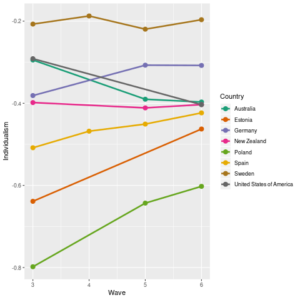In the last post I investigated the development of individualism in several countries, with the aim to investigate if individualism is something recent in Sweden. I used an indicator which I am rather sceptical about — the relation between importance of friends and family. The more important friends are related to the family the more individualistic. This is an indicator used, among others, to measure individualism. Maybe it is a good one, but to use it as standalone I think the variable rather measure family orientation — which of course can be related to individualism. But it is not the same thing.
Anyway, i look through and made the code I used more efficient, and then I found another pattern which I found really interesting. Family orientation is rather stable in Sweden but actually decreasing in most countries. The USA is an exception. However, USA is not alone. The other Anglo-Saxon show the same pattern. Another pattern is that family orientation in the east European countries have decreased rather fast.
First I made the code shorter and more efficient. As in the last post I will only show the codes for one of the waves — the codes for the other waves are about the same. There is thus no reason to show the codes for the other waves. As in the former post data comes from World Value Survey.
I use the countrycode package to transform the numeric country codes into factors.
library(countrycode) wd6$cntry <- countrycode (wd6$v2, origin = "wvs", destination = "un.name.en")
Individualism/family orientation is created from two variables measuring the importance of the family and friends. I first revert the scale, and then just take the importance of friends minus the importance of family. The higher the value the more individualistic — and the lesser is the family orientation.
wd6$family <- ifelse (wd6$v4 < 0, NA, wd6$v4) wd6$friends <- ifelse (wd6$v5 < 0, NA, wd6$v5) wd6$family <- (wd6$family - (max(wd6$family, na.rm = TRUE))) *-1 wd6$friends <- (wd6$friends - (max(wd6$friends, na.rm = TRUE))) *-1 wd6$individualism <- wd6$friends - wd6$family
The next step is to select the countries to use. I use the car-package to create a variable from which to select a subset.
library(car) wd6$cntry_select <- recode (wd6$cntry, ' "Australia" = 1; "Estonia" = 1; "Germany" = 1; "Netherlands" = 1; "New Zealand" = 1; "Poland" = 1; "Romania" = 1; "Spain" = 1; "Sweden" = 1; "United States of America" = 1; else = 0') wd6 <- subset (wd6, cntry_select==1)
The next step is to create a data.frame with the mean value of individualism/family orientation in each country. To do this I use the aggregate command. The new data frame is need of some cleaning.
t6b <- aggregate (wd6$individualism, list(wd6$cntry), FUN = mean, na.rm=TRUE) t6b$Country <- t6b$Group.1 t6b$Individualism <- t6b$x t6b <- t6b[c(-1,-2)]
This can be plotted using ggplot2.
p6 <- ggplot (data=t6b, aes(x= reorder (Country, -Individualism), y=Individualism)) + geom_bar (stat="identity", position=position_dodge()) + labs (x="Country", y="Individualism") + theme(axis.text.x=element_text(angle=90,hjust=1,vjust=0.5)) p6
After doing this for all the waves I will end up with five data frames, which are named: tb2, tb3, tb4, tb5, and tb6. Since the second wave does not include Sweden it is excluded. In each of these data frames I create a variable named Wave. The I bind them together.
t2b$Wave <- 2 t3b$Wave <- 3 t4b$Wave <- 4 t5b$Wave <- 5 t6b$Wave <- 6 df7 <- rbind (t3b,t4b,t5b, t6b)
To make visualisation easier to see I choose eight countries:
df7$country_select <- recode (df7$Country, ' c("Sweden", "United States of America", "Spain", "Poland", "Estonia", "Germany", "Australia", "New Zealand") = 1; else=0') df7 <- subset(df7, country_select == 1)
I then use ggplot to produce the graph.
p7 <- ggplot (data=df7, aes(x=Wave, y=Individualism, group=Country)) + geom_line (aes(color=Country), size=1.2) + geom_point(aes(color=Country), size = 3.1) + scale_color_brewer(palette="Dark2")
As can be seen individualism/family orientation is rather stable in Sweden, while decreasing in the USA (as we saw in the previous post). More interesting though is that individualism is not only decreasing in the USA, but also in Australia and New Zealand — two Anglo-Saxon countries. Other interesting results are the increase in individualism in the eastern European countries. The increase is Very strong in Poland and Estonia. But as can be seen individualism is also increasing in Germany and Spain. Even though we have to be cautious with conclusions it seems as the Anglo-Saxon countries and Sweden are outliers. Everywhere else is individualism on the increase. Furthermore, maybe this is not about primary about individualism — but about family orientation. Even though probably related, it is not the same thing.

Lämna ett svar